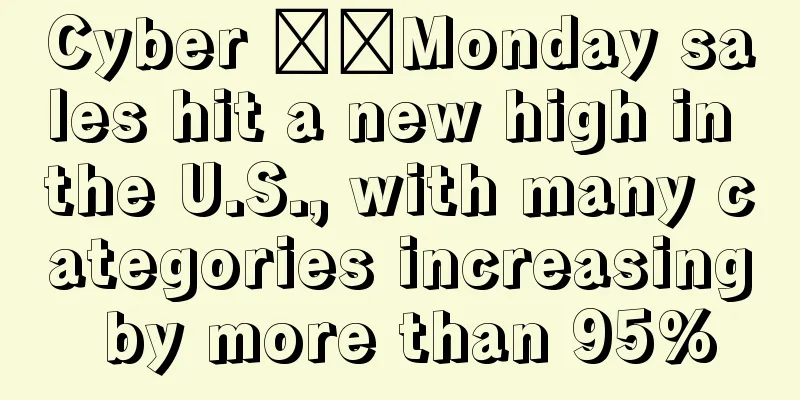"2022 US E-commerce Market Data Report": These two categories have the largest growth

|
It is learned that on March 22, at the Adobe Summit 2023, the world's largest digital experience conference, Adobe Analytics released a data report on the US e-commerce market in 2022, revealing important trends worthy of attention in the US e-commerce market in 2022.
The data revealed in the report is based on an analysis of more than 1 trillion visits to US retail websites, 100 million different products and 18 categories. The study shows that groceries and home furnishings are the fastest growing categories in US e-commerce sales, and the share of online orders using BNPL has increased significantly.
Home and groceries are growth drivers
Adobe found that in 2022, U.S. consumers spent more than $126 billion online on home furnishings, up 10.2% year-over-year, and $86.8 billion on groceries, up 10.8% year-over-year. The growth of these two categories outpaced the growth of the highest-share categories, including electronics and apparel.
Electronics remain the top category for online shopping by Americans, but sales only grew 4% year-over-year last year. Similarly, clothing is the top category for online shopping by Americans, but sales fell 3.8% year-over-year last year.
Online sales of home furnishings and groceries have continued to grow strongly since the beginning of 2023. In February this year, online sales of home furnishings in the United States increased by 12.9% year-on-year, with spending reaching $9.4 billion that month. Grocery sales increased by 26.7% year-on-year, with online shopping spending reaching $8.4 billion.
At the same time, online demand for electronic products continued to slow, with sales falling 5.4% year-on-year to $13.6 billion in February; clothing fell 0.6% year-on-year to $11.3 billion.
Buy Now Pay Later (BNPL) continues to grow
Adobe analysis also shows that by 2022, the share of online shopping orders using buy now, pay later (BNPL) services will increase by 14% year-on-year, and sales revenue will increase by 27% year-on-year.
In the first two months of 2023, BNPL order share increased by 10% year-on-year, but revenue fell by 19% year-on-year. Adobe said this shows that consumers are using this payment method for small purchases.
Adobe also looked at BNPL usage in major categories such as groceries, home goods, apparel and electronics. In the first two months of 2023, groceries’ share of BNPL orders grew 40%, while home goods grew 38%. In contrast, apparel grew only 8% and electronics fell 14%.
Other important trends
Mobile commerce continues to grow, with orders from smartphones accounting for 45% of total online sales in 2022. But based on the current growth trajectory, Adobe expects smartphones to drive the majority of online sales (over 50%) every month by December 2023.
Large retailers (over $1 billion in annual sales) have seen greater success with mobile shopping, with 38% more visits to mobile than small retailers (between $10 million and $50 million in annual sales). Small retailers also saw an 8.6% drop in smartphone sales revenue share.
Demand for curbside pickup also fell sharply in 2022. In 2021, 23% of online orders took advantage of the curbside pickup option, a figure that fell to 19% in 2022 and further to 17% in the first two months of 2023.
Editor✎ Ashley/ Disclaimer: This article is copyrighted and may not be reproduced without permission. |
Recommend
What is Dafiti? Dafiti Review
Dafiti is a leading online fashion retailer in Bra...
More than 18,000 Temu exclusive children's pajamas recalled in violation of federal regulations
It is learned that the U.S. Consumer Product Safet...
What is DMM? DMM Review
DMM was founded in 1999 and is a comprehensive web...
Amazon has opened another physical store. Will this have an impact on the sellers on the platform?
It is learned that according to foreign media repo...
Donald Trump's chances of winning the election increased after he was shot? If Trump is successfully elected president, what impact will it have on the cross-border industry?
Anonymous user My C position At a critical moment ...
Spittoons for $61! Mosquito nets for $409! These Chinese “local” products are popular overseas
Do you still remember LV's snakeskin bags, Cha...
Surprise! Amazon recently released two FBA notices, and sellers are happy!
During the recent Qingming Festival, I heard that ...
A seven-character limerick describing my experience in the cross-border e-commerce industry
I can endure hardships and work hard! I will never...
In 2024, don’t miss TikTok again
The hottest platform today is TikTok. The opportu...
What is Meteor Cross-border? Meteor Cross-border Review
Meteor Cross-border E-commerce is a subsidiary of ...
Study on US consumer cross-shopping behavior: Half of Walmart's buyers are lost to Amazon
Market research firm Numerator recently released a...
Order volume begins to increase! Wayfair will lay off employees again to reduce operating costs!
Online furniture retailer Wayfair will cut 1,750 ...
Walmart Mexico fined $4.6 million for suspected market monopoly, antitrust review continues
The Federal Economic Competition Commission (COFEC...
UPS released its third quarter financial report for 2024, with operating profit surging 47.8%
It is learned that on October 24, according to for...
The government refuses to support sellers in suing Amazon? Cross-border e-commerce will face compliance challenges!
▲ Video account attention: cross-border navigation...









